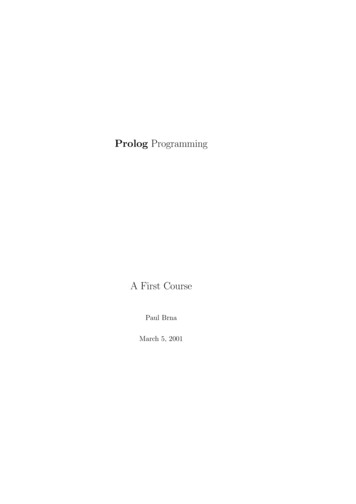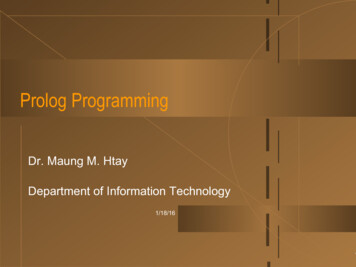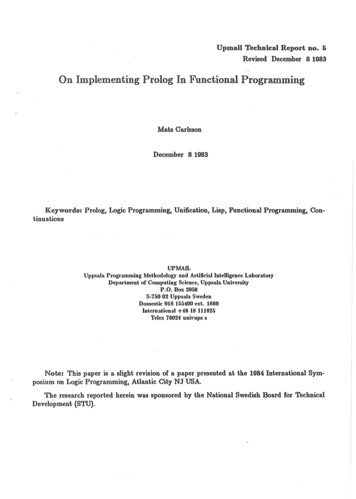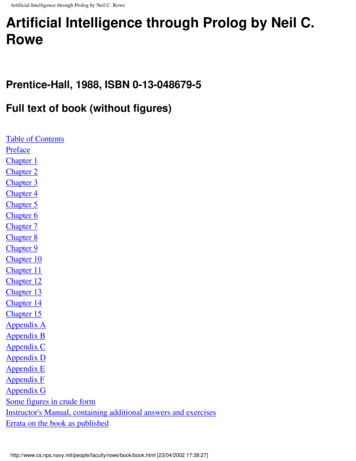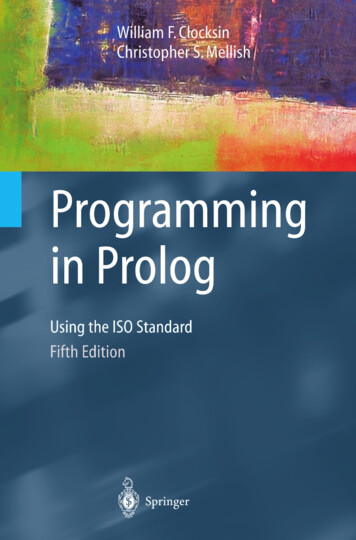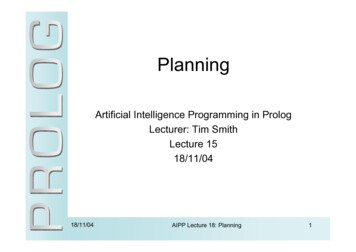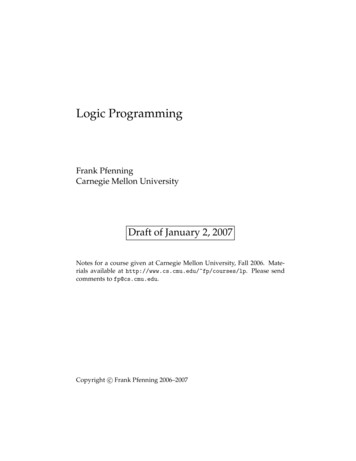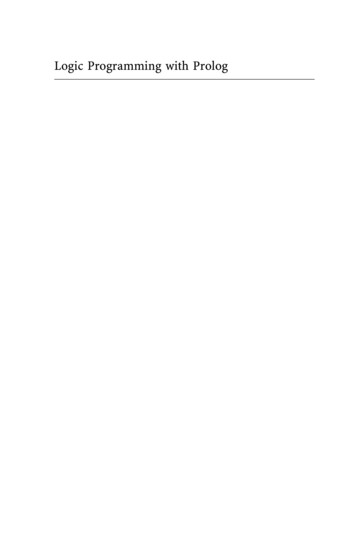
Transcription
Logic Programming with Prolog
Max BramerLogic Programmingwith Prolog
Max Bramer, BSc, PhD, CEng, FBCS, FIEE, FRSA, ILTMDepartment of Computer Science and Software EngineeringUniversity of PortsmouthUnited KingdomBritish Library Cataloguing in Publication DataA catalogue record for this book is available from the British LibraryLibrary of Congress Control Number: 2005923526Apart from any fair dealing for the purposes of research or private study, or criticism or review,as permitted under the Copyright, Designs and Patents Act 1988, this publication may be reproduced, stored or transmitted, in any form or by any means, with the prior permission in writingof the publishers, or in the case of reprographic reproduction in accordance with the terms oflicenses issued by the Copyright Licensing Agency. Enquiries concerning reproduction outsidethose terms should be sent to the publishers.ISBN-10: 1-85233-938-1ISBN-13: 978-1852-33938-8Springer Science Business Mediaspringeronline.com Max Bramer 2005The use of registered names, trademarks, etc. in this publication does not imply, even in theabsence of a specific statement, that such names are exempt from the relevant laws and regulations and therefore free for general use.The publisher makes no representation, express or implied, with regard to the accuracy of theinformation contained in this book and cannot accept any legal responsibility or liability for anyerrors or omissions that may be made.Printed in the United States of America34-543210 Printed on acid-free paperSPIN 11344445
IntroductionLogic Programming is the name given to a distinctive style of programming, verydifferent from that of conventional programming languages such as C and Java.Fans of Logic Programming would say that 'different' means clearer, simpler andgenerally better!Although there are other Logic Programming languages, by far the most widelyused is Prolog. The name stands for Programming in Logic. This book teaches thetechniques of Logic Programming through the Prolog language. Prolog is based onresearch by computer scientists in Europe in the 1960s and 1970s, notably at theUniversities of Marseilles, London and Edinburgh. The first implementation was atthe University of Marseilles in the early 1970s. Further development at theUniversity of Edinburgh led to a de facto standard version, now known asEdinburgh Prolog. Prolog has been widely used for developing complexapplications, especially in the field of Artificial Intelligence. Although it is ageneral-purpose language, its main strengths are for symbolic rather than fornumerical computation.The developers of the language were researchers working on automatingmathematical theorem proving. This field is often known as computational logic.But if you are not a Computer Scientist, a logician or a mathematician do not letthis deter you! This book is aimed at the 99.9% of the population who are none ofthese. Those who are, already have a number of excellent textbooks from which tochoose.The idea that the methods developed by computational logicians could be usedas the basis for a powerful general purpose programming language wasrevolutionary 30 years ago. Unfortunately most other programming languages havenot yet caught up.The most striking feature of Prolog for the newcomer is how much simpler theprograms look than in other languages. Many language designers started out withgood intentions but could not resist, or perhaps could not avoid, making theircreations over elaborate. In some languages even writing the customary testprogram to print out the words Hello World! to the user's screen is hard work. Allthe user has to do in Prolog is to enter write('Hello World!').
viIntroductionTraditional programming languages have one feature in common. They allcontain a series of instructions that are to be performed ('executed') one afteranother. This style of programming is called procedural. It corresponds closely tothe way computers are generally built. This is a tempting approach that has beenused since the 1950s but is ultimately flawed. The way users write programsshould depend as little as possible on how the underlying machine was built and asmuch as possible on what the user is trying to do. In just the same way, thefacilities I use when I drive my car should depend as little as possible on how theengine was designed or the carburettor works. I want all that level of detail hiddenfrom me, although in practice I understand that it may not be completely possibleto ignore it.Prolog programs are often described as declarative, although they unavoidablyalso have a procedural element. Programs are based on the techniques developedby logicians to form valid conclusions from available evidence. There are only twocomponents to any program: facts and rules. The Prolog system reads in theprogram and simply stores it. The user then types in a series of questions (strictlyknown as queries), which the system answers using the facts and rules available toit. This is a simple example, a series of queries and answers about animals. Theprogram consists of just seven lines (blank lines are ).cat(michael).cat(jane).animal(X):-dog(X).This program is not too hard to decipher. The first three lines are facts, with theobvious interpretation that fido, rover and henry are all dogs. The next three factssay that felix, michael and jane are all cats.The final line is a rule saying that anything (let us call it X) is an animal if it isa dog. Cat lovers may feel that cats can also claim to be called animals, but theprogram is silent about this.Having loaded the program, the user is then faced with the two charactersymbol ?- which is called the system prompt. To check whether fido is a dog allthat is necessary is to type the query dog(fido) followed by a full stop and press the'return' key, which indicates to the system that a response is needed. This gives thecomplete dialogue:?- dog(fido).yes
IntroductionviiThe user can enter a series of queries at the prompt, asking for furtherinformation.?-dog(jane).no[Is jane a dog? No - a cat]?- animal(fido).yes[Is fido an animal?][yes - because it is a dog and any dog is ananimal]?- dog(X).X fido ;X rover ;X henry[Is it possible to find anything, let us call it X, thatis a dog?]?-animal(felix).no[felix is a cat and so does not qualify as an animal,as far as the program is concerned][All 3 possible answers are provided]Although straightforward, this example shows the two components of anyProlog program, rules and facts, and also the use of queries that make Prologsearch through its facts and rules to work out the answer. Determining that fido isan animal involves a very simple form of logical reasoning:GIVEN THATany X is an animal if it is a dogANDfido is a dogDEDUCEfido must be an animalThis type of reasoning is fundamental to theorem proving in Mathematics andto writing programs in Prolog.Even very simple queries such as:?-dog(fido).can be looked at as asking the Prolog system to prove something, in this case thatfido is a dog. In the simplest cases it can do so simply by finding a fact such asdog(fido) that it has been given. The system answers yes to indicate that thissimple 'theorem' has been proved.You have now seen all three elements needed for logic programming in Prolog:facts, rules and queries. There are no others. Everything else is built from them.A word of warning is necessary at this stage. It is easy for the newcomer to getstarted with Prolog, but do not be fooled by these examples into thinking thatProlog is only capable of handling simple (Mickey Mouse?) problems. By putting
viiiIntroductionthese very basic building blocks together Prolog provides a very powerful facilityfor building programs to solve complex problems, especially ones involvingreasoning, but all Prolog programs are simple in form and are soundly based on themathematical idea of proving results from the facts and rules available.Prolog has been used for a wide variety of applications. Many of these are inMathematics and Logic but many are not. Some examples of the second type ofapplication are programs for processing a 'natural language' text, to answer questionsabout its meaning, translate it to another language etc. advisory systems for legal applications applications for training maintaining databases for the Human Genome project a personnel system for a multi-national computer company automatic story generation analysing and measuring 'social networks' a software engineering platform for supporting the development ofcomplex software systems automatically generating legally correct licences and other documents inmultiple languages an electronic support system for doctors.Prolog is also being used as the basis for a standard 'knowledge representationlanguage' for the Semantic Web – the next generation of internet technology.Prolog is one of the principal languages used by researchers in ArtificialIntelligence, with many applications developed in that field, especially in the formof Expert Systems – programs that 'reason out' the solution to complex problemsusing rules.Many textbooks on Prolog assume that you are an experienced programmerwith a strong background in Mathematics, Logic or Artificial Intelligence(preferably all three). This book makes no such assumptions. It starts from scratchand aims to take you to a point where you can write quite powerful programs in thelanguage, often with considerably fewer lines of program 'code' than would beneeded in other languages.You do not need to be an experienced programmer to learn Prolog. Some initialfamiliarity with basic computing concepts such as program, variable, constant andfunction would make it easier to achieve, but paradoxically too much experience ofwriting programs in other languages may make the task harder – it may benecessary to unlearn bad habits of thinking learnt elsewhere.
IntroductionixSome Technical DetailsExperienced programmers will search this book in vain for such standard languagefeatures as variable declarations, subroutines, methods, for loops, while loops orassignment statements. (If you don't know what these terms mean, don't worry –you will not be needing them.)On the other hand experienced readers may like to know that Prolog has astraightforward uniform syntax, programs that are equivalent to a database of factsand rules, a built-in theorem prover with automatic backtracking, list processing,recursion and facilities for modifying programs (or databases) at run-time. (Youprobably will not know what most of these mean either – but you will be using allof them by the end of this book.)Prolog lends itself to a style of programming making particular use of twopowerful techniques: recursion and list processing. In many cases algorithms thatwould require substantial amounts of coding in other languages can beimplemented in a few lines in Prolog.There are many versions of Prolog available for PC, Macintosh and Unixsystems, including versions for Microsoft Windows, to link Prolog to an Oraclerelational database and for use with 'object-oriented' program design. These rangefrom commercial systems with many features to public domain and 'freeware'versions. Some of these are listed (in alphabetical order) below, together with webaddresses at which more information can be found. Amzi! Prologhttp://www.amzi.com/products/prolog products.htm B-Prologhttp://www.probp.com/ Ciao Prologhttp://clip.dia.fi.upm.es/Software/Ciao/ GNU Prologhttp://gnu-prolog.inria.fr/ Logic Programming Associates Prolog (versions for Windows, DOS andMacintosh)http://www.lpa.co.uk Open Prolog (for Apple Macintosh)http://www.cs.tcd.ie/open-prolog/ PD Prolog (a public domain version for MS-DOS ository/ai/lang/prolog/impl/prolog/pdprolog/0.html SICStus .html
xIntroduction SWI Prologhttp://www.swi-prolog.org/ Turbo Prolog (an old version that only runs in log.html Visual Prologhttp://www.visual-prolog.com/ W-Prolog (a Prolog-like language that runs in a web browser)http://goanna.cs.rmit.edu.au/ winikoff/wp/ YAP Prologhttp://www.ncc.up.pt/ vsc/Yap/The programs in this book are all written using the standard 'Edinburgh syntax'and should run unchanged in virtually any version of Prolog you encounter(unfortunately, finding occasional subtle differences between implementations isone of the occupational hazards of learning any programming language). Featuressuch as graphical interfaces, links to external databases etc. have deliberately notbeen included, as these generally vary from one implementation to another. All theexamples given have been tested using Win-Prolog version 4.110 from the Britishcompany Logic Programming Associates (www.lpa.co.uk).Each chapter has a number of self-assessment exercises to enable you to checkyour progress. A full glossary of the technical terms used completes the book.
Contents1. Getting Started11.1 Starting Prolog1.2 Prolog Programs1.3 Data Objects in Prolog: Prolog TermsPractical Exercise 1138122. Clauses and Predicates132.1 Clauses2.2 Predicates2.3 Loading Clauses2.4 VariablesPractical Exercise 213151921273. Satisfying Goals29Introduction3.1 Unification3.1.1 Unifying Call Terms3.2 Evaluating Goals3.3 Backtracking3.4 Satisfying Goals: A Summary3.5 Removing Common Variables3.6 A Note on Declarative ProgrammingPractical Exercise 32931323539505252554. Operators and Arithmetic574.1 Operators4.2 Arithmetic4.3 Equality Operators4.4 Logical OperatorsPractical Exercise 45759636668
xiiContents5. Input and Output69Introduction5.1 Outputting Terms5.2 Inputting Terms5.3 Input and Output Using Characters5.4 Outputting Characters5.5 Inputting Characters5.6 Using Characters: Examples5.7 Input and Output Using Files5.8 File Output: Changing the Current Output Stream5.9 File Input: Changing the Current Input Stream5.9.1 Reading from Files: End of File5.9.2 Reading from Files: End of Record5.10 Using Files: ExamplesPractical Exercise 569697172737374777778787979826. Loops85Introduction6.1 Looping a Fixed Number of Times6.2 Looping Until a Condition Is Satisfied6.2.1 Recursion6.2.2 Using the 'repeat' Predicate6.3 Backtracking with Failure6.3.1 Searching the Prolog Database6.3.2 Finding Multiple SolutionsPractical Exercise 68585898991949496977. Preventing Backtracking99Introduction7.1 The Cut Predicate7.2 Cut with FailurePractical Exercise 799991061088. Changing the Prolog Database1098.1 Changing the Database: Adding and Deleting Clauses8.2 Adding Clauses8.3 Deleting Clauses8.4 Changing the Database: Example8.5 Maintaining a Database of FactsPractical Exercise 8109110111112114118
Contents9. List Processing1199.1 Representing Data as Lists9.2 Notation for Lists9.3 Decomposing a List9.4 Built-in Predicate: member9.5 Built-in Predicate: length9.6 Built-in Predicate: reverse9.7 Built-in Predicate: append9.8 List Processing: Examples9.9 Using findall/3 to Create a ListPractical Exercise 911912012212512612612712913313610. String Processing13710.1 Converting Strings of Characters To and From Lists10.2 Joining Two Strings10.3 Trimming a String10.4 Inputting a String of Characters10.5 Searching a String10.6 Dividing a String into Its Component PartsPractical Exercise 1013713913914114214414711. More Advanced Features149Introduction11.1 Extending Prolog: Arithmetic11.2 Extending Prolog: Operations on Strings11.3 Extending Prolog: Sets11.4 Processing TermsPractical Exercise 11149149155157160166Appendix 1. Built-in Predicates167Appendix 2. Built-in Operators179Appendix 3. Specimen Solutions to Practical Exercises185Appendix 4. Glossary209Index221xiii
1Getting StartedChapter AimsAfter reading this chapter you should be able to: Write and load a simple Prolog program Enter goals at the Prolog system prompt Understand the basic terminology of the Prolog language Distinguish between different types of term (data objects).1.1 Starting PrologStarting the Prolog system is usually straightforward, but the precise details willvary from one version to another. Consult the documentation if necessary. StartingProlog will generally produce a number of lines of headings followed by a linecontaining just?This is the system prompt. (In some versions of Prolog a slightly differentcombination of characters may be used.)The prompt indicates that the Prolog system is ready for the user to enter asequence of one or more goals, which must be terminated by a full stop, forexample:?- write('Hello World'),nl,write('Welcome to Prolog'),nl.
2Logic Programming With Prolognl stands for 'start a new line', as will be explained later. Like all other userinput, the above line does not have any effect until the 'return' key is pressed.Doing so produces the outputHello WorldWelcome to Prologyesfollowed by a further system prompt ?-.In this book a sequence of goals entered by the user will generally be shownpreceded by the ?- prompt. The prompt must not be typed by the user. It isgenerated automatically by the Prolog system to show that it is ready to receive asequence of goals.In the above example, the user has entered a sequence of four goals:write('Hello World'), nl (twice) and write('Welcome to Prolog'). The commasseparating the goals signify 'and'.In order for the sequence of goalswrite('Hello World'),nl,write('Welcome to Prolog'),nlto succeed each of the following goals has to succeed in order:write('Hello World')Hello World has to be displayed on the user's screennla new line has to be output to the user's screenwrite('Welcome to Prolog')Welcome to Prolog has to be displayed on the user's screennlA new line has to be output to the user's screen.The Prolog system can achieve all these goals simply by outputting lines of textto the user's screen. It does so and then outputs yes to indicate that the sequence ofgoals has succeeded.From the system's point of view, the important issue is whether or not thesequence of goals entered by the user succeeds. The generation of output to thescreen is considered much less important and is described as (merely) a side effectof evaluating the goals write('Hello World') etc.The meanings of write and nl are pre-defined by the Prolog system. They areknown as built-in predicates, sometimes abbreviated to BIPs.Two other built-in predicates that are provided as standard in almost allversions of Prolog are halt and statistics.?-halt.
Getting Started3causes the Prolog system to terminate.?- statistics.causes system statistics (of value mainly to more experienced users) such as thefollowing to be generated.Memory Statistics-----------------------Reset SpaceHeap SpaceInput SpaceOutput SpaceFree Bytes-------------655362618506553665536Total Bytes--------------655362621306553665536Total Elapsed Time 626.871(100%)Active ProcessingWaiting for Inputyes( 100%)(100%)Note that this output ends with the word yes, signifying that the goal hassucceeded, as statistics, halt and many other built-in predicates always do. Theirvalue lies in the side effects (generating statistics etc.) produced when they areevaluated.A sequence of one or more goals entered by the user at the prompt is oftencalled a query. We will generally use the term 'sequence of goals' in this book.1.2 Prolog ProgramsEntering a goal or a sequence of goals at the system prompt using only built-inpredicates would be of little value in itself. The normal way of working is for theuser to load a program written in the Prolog language and then enter a sequence ofone or more goals at the prompt, or possibly several sequences in succession, tomake use of the information that has been loaded into the database.The simplest (and most usual) way to create a Prolog program is to type it intoa text editor and save it as a text file, say prog1.pl.This is a simple example of a Prolog program. It has three components, knownas clauses, each terminated by a full stop. Note the use of blank lines to improvereadability – they are ignored.dog(fido).cat(felix).animal(X):-dog(X).
4Logic Programming With PrologThe program can then be loaded for use by the Prolog system using the built-inpredicate consult.?-consult('prog1.pl').Provided that the file prog1.pl exists and the program is syntactically correct,i.e. contains valid clauses, the goal will succeed and as a side effect produce one ormore lines of output to confirm that the program has been read correctly, e.g.?# 0.00 seconds to consult prog1.pl?If the Prolog system has a graphical user interface, there will probably be a 'Load'option provided on a menu as an alternative to using consult. This and other menuoptions such as 'exit' are not a standard part of the Prolog language and will not bedescribed in this book.Loading a program simply causes the clauses to be placed in a storage areacalled the Prolog database. Entering a sequence of one or more goals in responseto the system prompt causes Prolog to search for and use the clauses necessary toevaluate the goal(s). Once placed in the database the clauses generally remain thereuntil the user exits from the Prolog system and so can be used to evaluate furthergoals entered by the user.TerminologyIn the program above the three lines:dog(fido).cat(felix).animal(X):-dog(X).are all clauses. Each clause is terminated by a full stop. Apart from comments andblank lines, Prolog programs consist only of a sequence of clauses. All clauses areeither facts or rules.dog(fido) and cat(felix) are examples of facts. They can be interpreted in anatural way as meaning 'fido is a dog' and 'felix is a cat'.dog is called a predicate. It has one argument, the word fido enclosed in ( ).fido is called an atom (meaning a constant which is not a number).The final line of the programanimal(X):-dog(X).
Getting Started5is a rule. The :- character (colon and hyphen) can be read as 'if'. X is called avariable. The meaning of a variable used in a rule or fact is described in Chapter 2.In this context X represents any value, as long as it is the same value both times.The rule can be read in a natural way as X is an animal if X is a dog (for any X).From the above clauses it is simple (for humans) to deduce that fido is ananimal. Prolog can also make such deductions:?- animal(fido).yesHowever there is no evidence to imply that felix is an animal:?- animal(felix).noMore TerminologyWe say that a goal succeeds or fails, or alternatively that it is satisfied or cannot besatisfied. The term evaluating a goal is used to mean determining whether or not itis satisfied. Equivalently, we can say that a goal evaluates to true (i.e. succeeds) orfalse (i.e. fails). This all fits in well with the everyday definition of a goal as'something to be achieved'.Note that sometimes a goal entered by the user can be interpreted as acommand, e.g.?-halt.'Exit from the Prolog system.'At other times it can be regarded as a question, e.g.?-animal(fido).'Is fido an animal?'Here is another program about animals. This one comprises eight clauses. Alltext between /* and */ is taken to be a comment and ignored./* Animals Program 1*/dog(fido).cat(mary). dog(rover).dog(tom). cat(harry).dog(henry).cat(bill). cat(steve)./* Apart from comments and blank lines, which areignored, Prolog programs consist of a number ofclauses. A clause is always terminated by a full stop.
6Logic Programming With PrologIt may run over more than one line, or there may beseveral on the same line, separated by at least onespace. There are two types of clause: facts and rules.dog(tom) is an example of a fact */There are four clauses for predicate dog and four for predicate cat. We say thatthe program comprises four clauses defining the dog predicate and four definingthe cat predicate.Assuming that the program has been saved in a text file 'animals1.pl', the outputgenerated by loading the program and entering a sequence of goals at the systemprompt is given below.?-consult('animals1.pl').# 0.01 seconds to consult animals1.plSystem promptanimals1.pl loaded using consult?-dog(fido).yes?-dog(daisy).No?- dog(X).X fidopauses – user presses return key?- dog(Y).Y fido ;Y rover ;Y tom ;Y henrypauses – user presses ;pauses – user presses ;pauses – user presses ;No pause – goes on to next line?- cat(X).X mary ;X harrypauses – user presses ;pauses – user presses return?- listing(dog).List all the clauses defining predicate dog/* dog/1 */dog( fido ).dog( rover ).dog( tom ).dog( henry ).yes?-
Getting Started7There are several new features of Prolog introduced in this example. The query?- dog(X).(a single goal) means 'find a value of X for which the goal dog(X) is satisfied', oreffectively 'find a value of X which is the name of a dog'. Prolog answersX fidoHowever there are other possible answers (rover, tom and henry). Because ofthis Prolog pauses and waits for the user to press the 'return' key before it outputsthe system prompt ?-.The next query entered is?- dog(Y).This is essentially the same query as before. It is unimportant which variable (Xor Y) is used. The query means 'find a value of Y which is the name of a dog'.Prolog answersY fidoand again pauses. This time the user presses the ; (semicolon) key. Prolog nowlooks for an alternative solution or, more precisely, an alternative value of Y thatsatisfies the goal dog(Y). It repliesY roverIt pauses again and the user again presses the ; key. A further solution is givenY tomProlog pauses again. The user again presses the ; key, producing a furthersolutionY henryThis time there are no more solutions available and Prolog recognises this bynot pausing, but immediately going on to output the system prompt ?-.The process of finding alternative ways of satisfying a goal by entering asemicolon at the system prompt is known as backtracking, or more precisely'forcing the Prolog system to backtrack'. Backtracking will be discussed in moredetail in Chapter 3.The example also introduces a new built-in predicate. Entering the goal?-listing(dog).
8Logic Programming With Prologcauses Prolog to list all four clauses defining predicate dog, in the order in whichthey were loaded into the database (which is the same as the order in which theyappeared in file animals1.pl).The next example shows more about the use of variables in queries. Thesequence of goals?-cat(X),dog(Y).gives all possible combinations of a dog and a cat.?-cat(X),dog(Y).X mary ,Y fido ;X mary ,Y rover ;X mary ,Y tom ;X mary ,Y henry ;etc.By contrast, the sequence of goals?-cat(X),dog(X).gives all animals which are both a cat and a dog (there are no such animals in thedatabase). Although X stands for 'any value' in both cat(X) and dog(X) they mustboth be the same value.?- cat(X),dog(X).no1.3 Data Objects in Prolog: Prolog TermsThe data objects in Prolog are called terms. Examples of terms that have been usedin Prolog programs so far in this book are fido, dog(henry), X and cat(X).There are several different types of term, which are listed below.
Getting Started9(1) NumbersAll versions of Prolog allow the use of integers (whole numbers). They are writtenas any sequence of numerals from 0 to 9, optionally preceded by a or - sign, forexample:623-47 5025Most versions of Prolog also allow the use of numbers with decimal points.They are written in the same way as integers, but contain a single decimal point,anywhere except before an optional or - sign, e.g.6.43-.245 256.(2) AtomsAtoms are constants that do not have numerical values. There are three ways inwhich atoms can be written.(a) Any sequence of one or more letters (upper or lower case), numerals andunderscores, beginning with a lower case letter, e.g.johntoday is Tuesdayfred jonesa32 BCDbut notTodaytoday-is-Tuesday32abc(b) Any sequence of characters enclosed in single quotes, including spaces andupper case letters, e.g.'Today is Tuesday''today-is-Tuesday''32abc'(c) Any sequence of one or more special characters from a list that includes thefollowing - * / & # @ :
10Logic Programming With PrologExamples -(3) VariablesIn a query a variable is a name used to stand for a term that is to be determined,e.g. variable X may stand for atom dog, the number 12.3, or a compound term or alist (both to be described below). The meaning of a variable when used in a rule orfact is described in Chapter 2.The name of a variable is denoted by any sequence of one or more letters(upper or lower case), numerals and underscores, beginning with an upper caseletter or underscore, e.g.XAuthorPerson A123Abut not45 ABCPerson-AauthorNote: The variable which consists of just a single underscore is known as theanonymous variable and is reserved for a special purpose (see Chapter 2).(4) Compound TermsCompound terms are of fundamental importance in writing Prolog programs. Acompound term is a structured data type that begins with an atom, known here as afunctor. The functor is followed by a sequence of one or more arguments, whichare enclosed in brackets and separated by commas. The general form isfunctor(t1,t2, ,tn)n 1If you are familiar with other programming languages, you may find it helpfulto think of a compound term as representing a record structure. The functorrepresents the name of the record, while the arguments represent the record fields.The number of arguments a compound term has is called its arity. Someexamples of compound terms are:likes(paul,prolog)read(X)
Getting Started11dog(henry)cat(X) (3,2)person('john smith',32,doctor,london)Each argument of a compound term must be a term, which can be of any kindincluding a compound term. Thus some more complex examples of compoundterms a,Q)))(5) ListsA list is often considered to be a special type of compound term, but i
Prolog is also being used as the basis for a standard 'knowledge representation language' for the Semantic Web – the next generation of internet technology. Prolog is one of the principal languages used by researchers in Artificial Intelligence, with many app

